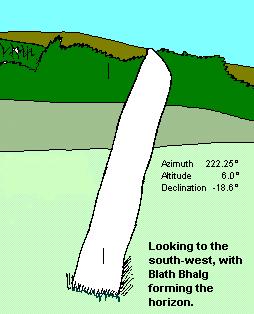
Straloch, Perthshire
Stones
of Wonder
QUICK LINKS ...
HOME PAGE
INTRODUCTION
WATCHING
THE SUN, MOON AND STARS
THE
MONUMENTS
THE
PEOPLE AND THE SKY
BACKGROUND
ARCHAEOASTRONOMY
USING
THE SITE DESCRIPTION PAGES
VISITING
THE SITES
THE
LEY LINE MYSTERY
THE
SITES
ARGYLL
AND ARRAN
MID
AND SOUTH SCOTLAND
NORTH
AND NORTH-EAST SCOTLAND
WESTERN
ISLES AND MULL
Data
DATES
OF EQUINOXES AND SOLSTICES, 1997 to 2030 AD
DATES
OF MIDSUMMER AND MIDWINTER FULL MOONS, 1997 to 2030 AD
POSTSCRIPT
Individual
Site References
Bibliography
Links
to other relevant pages
Contact
me at : rpollock456@gmail.com
Standing stone NO038637*
How to find: About 2km north of the village of Enochdhu on the A924 Blairgowrie - Pitlochry route the standing stone will be found in a field to the left, just opposite the entrance gate to Straloch House. The stone is down by the river, and not clearly visible from the road itself.
Best time to visit: Lunar major standstill; ? lunar minor standstill.
This is a single stone over two metres tall, standing in a field above the river Ardle. The stone has striking striations on its south-eastern face, which is possibly why it was selected for use. It is just under a metre wide and only 40cm thick, and leans to the north-west. Like many standing stones, it has had long use as a scratching post for cattle.
The survey was done using a ranging pole to assess the horizon points indicated by the stone when it stood vertically.
To the north-east, a distant hill horizon is just visible beyond the higher part of the field. The azimuth of 42.25° and the altitude of 5.1° gives a declination of +28.4°. This line is the rising position of the winter full moon at its most northerly point, during the major standstill.
 To
the south-west, the horizon in view is formed by the summit and northern
slopes of Blath Bhalg, about 2.5km away. The stone's bearing in this direction
of 222.25° with a horizon height on the hill of 6.0° gives a declination
value of -18.6°, close to the setting position of the winter moon
at the minor standstill. The dip in the hill just to the left of the summit
is the only feature on an otherwise smooth horizon, and this dip produces
a declination value of -20.3°, a closer match with the minor standstill
moon. Looking for suitable horizon notches has generally been avoided
in this Web guidebook however!
To
the south-west, the horizon in view is formed by the summit and northern
slopes of Blath Bhalg, about 2.5km away. The stone's bearing in this direction
of 222.25° with a horizon height on the hill of 6.0° gives a declination
value of -18.6°, close to the setting position of the winter moon
at the minor standstill. The dip in the hill just to the left of the summit
is the only feature on an otherwise smooth horizon, and this dip produces
a declination value of -20.3°, a closer match with the minor standstill
moon. Looking for suitable horizon notches has generally been avoided
in this Web guidebook however!
At any rate it is unlikely that both lines, to the south-west and to the north east were to be deliberately indicated by this single stone. Which of the lines is the preferred one can only be left open.